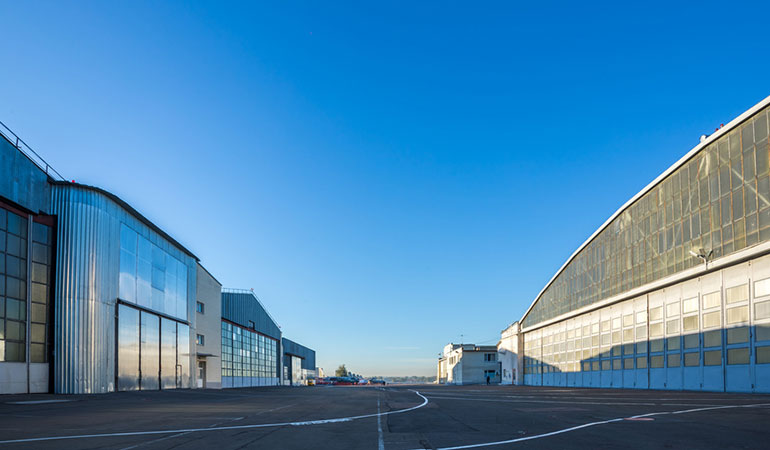An aircraft hangar is much more than just the roof over your plane. It’s a massive factor in terms of safety and revenue. That’s why you should pay particular attention to an aircraft hangar’s design. Here are some of the most important factors you need to consider when buying or building a hangar.
As a hangar manager, two things should be your top priority: safety and profit. Most of the time one doesn’t go without the other, anyway. But these factors aren’t only yours to affect, sometimes outer circumstances help or restrict you in your everyday business – for example the design of your hangar. So make sure your aircraft hangar design meets these 5 criteria:
#1: Building regulations for aircraft hangars
This should be self-evident. Your hangar has to meet your countries building and safety regulations, affecting the construction material used, the fire protection system, the people designing and building your hangar, and much more. If you cheat on any of these things you will regret this eventually. Plus: Make sure you always stay up-to-date on all required regulations even after the hangar is complete.
#2: Not too little, not too much – what’s the right slope?
Every hangar needs a certain slope. Otherwise, meltwater, rain, and other fluids couldn’t drain off, and the hangar would flood. But what is the right degree? Towing an aircraft is tough. Pulling all this weight is a difficult job and a challenge not only to the aircraft tug used but to the plane’s nose gear as well. It has to withstand all the traction and carry the weight of the aircraft. If you are pulling an aircraft uphill, it becomes much more difficult to tow since its weight is pulling it back downhill. Therefore, most aircrafts aren’t allowed to be towed up a hill that has more than 2 % slope, some exceptions allow up to a maximum of 4 %. So for a universal hangar, you should aim to stay beneath this 2 % slope.
#3: Good aircraft hangar design includes a fitting floor
As aviation enthusiasts, we tend to keep our eyes up in the sky. But sometimes it’s important to look at the ground we are standing on. Lately, hangar designers fancy smooth, shiny floors. We have to admit, they look pretty cool. But you know what’s not cool? Aircraft tugs that start sliding, or employees who slip and fall.
Perfectly smooth flooring is incredibly slippery. If the floor happens to be wet, the aircraft tug might not get enough grip to tow the aircraft out of the hangar. The tug’s wheels start spinning, leaving ugly skid marks, and the airplane isn’t going anywhere. Then again, if the aircraft is already moving, it can get difficult to brake and you risk causing an accident. Therefore, it’s important to have flooring that has sand mixed into it with a grain size of at least 2 mm. Better grip equals more safety.
Extra tip: For the flooring, go for a color that makes it easy to spot objects that might have dropped on it, for example, light gray RAL 7035.
#4: Gateway to great aircraft hangar design – the right hangar doors
There are dozens of different types of hangar doors: sliding, folding, lifting, you name it. All of them have their ups and downs, but what you should pay special attention to – regardless of the type of hangar door – is the threshold. It is important that it is as close to ground-level as possible. Everything above or beneath that is an obstacle and therefore a heavy load for the nose gear of your aircraft. Even if you can overcome such a threshold you will need much more force for it and it will make the aircraft bounce, putting even more weight on it.
#5: Pillars, additional gates: good aircraft hangar design is a question of layout, too
If you want to get the best revenue out of your hangar, its layout is a major factor for that. Particularly big aircraft hangars or for example production halls often have pillars because cantilever roofs are more expensive. As you can imagine, using the given space efficiently is quite difficult in these hangars, as a result, you can’t store as many airplanes in them as you would like to. Therefore, you should consider getting a hangar without pillars in the first place or invest in GSE solutions that allow you to use every square meter of it.
If you are still using a towbar, you will need additional gates on the other side of the hangar to let the tow tractor roll out of it if you want to park the aircraft all the way in the back. This implies that you have an infrastructure behind the hangar, too. If you want to avoid the extra costs that come along with this solution you should consider using small, towbarless tugs.
Conclusion to good aircraft hangar design
If you are going to buy or to build an aircraft hangar, its design and layout have many features that you should pay attention to. The safety of your staff and equipment as well as the revenue of your business depend massively on the property you are going to be working in.
If you are looking for more advice on how to increase your profitability, get a free copy of our eBook on ground handling right now!


Comments